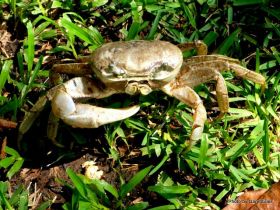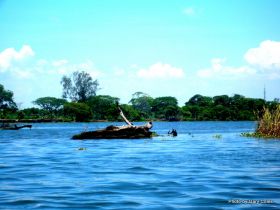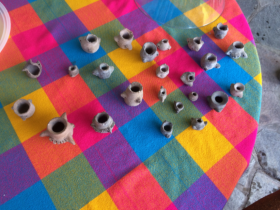How’s the ecotourism in Mexico?
Gary Coles - Paradise For Gringos
.JPG) There are many opportunities for ecotourism in Mexico. It is interesting that a Mexican architect Hector Ceballos-Lascurain actually coined the term “ecotourism” in 1983. The concept of responsible travel with an emphasis on conservation, education, and the well-being of the local population has been around much longer.
There are many opportunities for ecotourism in Mexico. It is interesting that a Mexican architect Hector Ceballos-Lascurain actually coined the term “ecotourism” in 1983. The concept of responsible travel with an emphasis on conservation, education, and the well-being of the local population has been around much longer.  Mexico has a tremendous biological diversity. It has almost every type of ecosystem. The...
Mexico has a tremendous biological diversity. It has almost every type of ecosystem. The....JPG) There are many opportunities for ecotourism in Mexico. It is interesting that a Mexican architect Hector Ceballos-Lascurain actually coined the term “ecotourism” in 1983. The concept of responsible travel with an emphasis on conservation, education, and the well-being of the local population has been around much longer.
There are many opportunities for ecotourism in Mexico. It is interesting that a Mexican architect Hector Ceballos-Lascurain actually coined the term “ecotourism” in 1983. The concept of responsible travel with an emphasis on conservation, education, and the well-being of the local population has been around much longer.  Mexico has a tremendous biological diversity. It has almost every type of ecosystem. The Mexican government states that Mexico has 108,519 different species including 535 mammals, 1,096 birds, 2,692 fish, and 29,192 plants.
Mexico has a tremendous biological diversity. It has almost every type of ecosystem. The Mexican government states that Mexico has 108,519 different species including 535 mammals, 1,096 birds, 2,692 fish, and 29,192 plants. Mexico has 158 designated "Natural Areas" including parks, reserves, sanctuaries and other protected areas. Their total area is 11% of the country.
 There are seven World Heritage Natural Sites:
There are seven World Heritage Natural Sites: - Sian Ka'an Biosphere Reserve
- Whale Sanctuary of El Vizcaíno Biosphere Reserve
- Ancient Maya City and Protected Tropical Forests of Calakmul, Campeche
- Islands and Protected Areas of the Gulf of California
- Monarch Butterfly Biosphere Reserves
- El Pinacate Y Gran Desierto de Alar Biosphere Reserve
- Archipiélago de Revillagigedo

Most of the areas have small companies that give tours based on the concept of ecotourism. It is also possible to do some research and set up your own personal tour.
My visit to El Pinacate is an example. I did the basic research and then we took our own tour. We were able to travel at our own pace and we were careful to respect the area and to be responsible visitors. I learned a lot and continually try to educate others about its unique natural value.
Posted December 18, 2016
Centeya - Radisson Blu Ajijic
 It was a bit of a culture shock for me to move back to Mexico from San Francisco. In San Francisco, if you don’t segregate your trash, you get fined. Here in Chapala, I’ve noticed that a lot of people don’t observe this, although I’ve seen that the guys collecting the garbage would segregate the trash themselves. Hopefully, they’re doing this because of the eco-friendliness of this aspect, but I know it’s more likely because they can trade in the...
It was a bit of a culture shock for me to move back to Mexico from San Francisco. In San Francisco, if you don’t segregate your trash, you get fined. Here in Chapala, I’ve noticed that a lot of people don’t observe this, although I’ve seen that the guys collecting the garbage would segregate the trash themselves. Hopefully, they’re doing this because of the eco-friendliness of this aspect, but I know it’s more likely because they can trade in the... It was a bit of a culture shock for me to move back to Mexico from San Francisco. In San Francisco, if you don’t segregate your trash, you get fined. Here in Chapala, I’ve noticed that a lot of people don’t observe this, although I’ve seen that the guys collecting the garbage would segregate the trash themselves. Hopefully, they’re doing this because of the eco-friendliness of this aspect, but I know it’s more likely because they can trade in the aluminum cans, plastic and cardboard, and make an extra penny off of it.
It was a bit of a culture shock for me to move back to Mexico from San Francisco. In San Francisco, if you don’t segregate your trash, you get fined. Here in Chapala, I’ve noticed that a lot of people don’t observe this, although I’ve seen that the guys collecting the garbage would segregate the trash themselves. Hopefully, they’re doing this because of the eco-friendliness of this aspect, but I know it’s more likely because they can trade in the aluminum cans, plastic and cardboard, and make an extra penny off of it. The level of Mexico’s concern about ecological issues varies in different areas within the country. I went to high school in Cancún, and a lot of my friends and classmates from there are now scuba divers, own scuba shops, or are into politics. They’re very keen on making sure that the reefs in Cancún are maintained despite environmental hazards that are getting worse every year. I’ve seen a lot of organizations on social media in which the locals are doing their best to preserve the reefs.
In Lake Chapala, we’ve done several manifestations of this. My friends and I have gone into Guadalajara and dress up as the Nahuatl, which is what the local indigenous people are called. Nahuatl got its name from the goddess of the lake Misti Chihuali.
In the recent years, the Mexican government had planned to build a big aqueduct out east of Ajijic. The residents didn’t want that to happen because it would result in the loss of a lot of water. The reason for building the aqueduct was to cut the water coming into Lake Chapala to feed more water into Guadalajara.
On the contrary, the aqueduct turned out to be a positive thing, because there was an existing aqueduct, but it was so old that it was leaking and wasting a lot of water. With the new aqueduct, the people were able to solve the leakage problem.
The responsiveness of the government and other people to ecological concerns depends on how big you make it. Here in Lake Chapala, you won’t see trash on the streets like you would in different parts of Mexico. The community has been cleaning up a lot. The government does what it can as far as what’s within its reach.
(Collection of minature pots found in Lake Chapala, possible offered to the goddess of the lake by the native people, pictured.)
Posted April 24, 2018



.png)